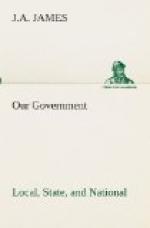Article II, Section 1, Clause 3. The Congress may determine the time of choosing the electors, and the day on which they shall give their votes, which day shall be the same throughout the United States.
At present, the appointment of electors is a necessary but a comparatively unimportant step in the election of a President.
The real power exists in the National conventions of the great political parties. Instead of exercising the right of free choice, as they were originally expected to do, the electors are really bound to vote for candidates nominated in these conventions. Let us consider, then, some of the chief points in the history and practical working of National conventions.
Early Methods of Nominating.—Like the development of other political usages, the method of nominating a President passed through several stages before the present plan of nominating conventions was reached. No nominations were made in the first two Presidential elections. In 1796, Washington having refused to be a candidate for a third term, party managers in Congress agreed informally on Adams and Jefferson as the candidates of the Federalist and the Republican parties respectively. A caucus of Federalist Congressmen, in 1800, nominated Adams and Pinckney, and a caucus of Republican Congressmen nominated Jefferson and Burr, for the offices of President and Vice-President. The Republican members of Congress continued to hold a regular caucus and thus to direct the votes of the party electors until 1824. In that year William H. Crawford, the last Congressional nominee, was defeated. There was opposition to the Congressional caucus from the beginning, for such a method was regarded as undemocratic. In 1824 and 1828 the several State legislatures put forward their favorites for the office of President.
Development of National Conventions.—As early as 1812, De Witt Clinton was nominated as the candidate of the Federalists in a convention held in New York City, made up of seventy delegates, who represented eleven States. But the National nominating convention, as we know it, was used for the first time by the Anti-Masonic party, which selected William Wirt for its candidate in 1831. This method was followed in the same year by the National Republican party, which nominated Henry Clay. The National convention of the Democratic party in 1832 nominated Andrew Jackson, who had already been nominated by many local conventions and State legislatures. Many years elapsed before the present complex organization was reached, but since 1836, with the single exception of the Whig party in that year, parties have regarded the National convention as an essential factor in electing President and Vice-President.
Prior to the nominations for the Presidency in 1912, the usual plan was to select two delegates to the National convention from each of the Congressional districts, and also four delegates at large. The




